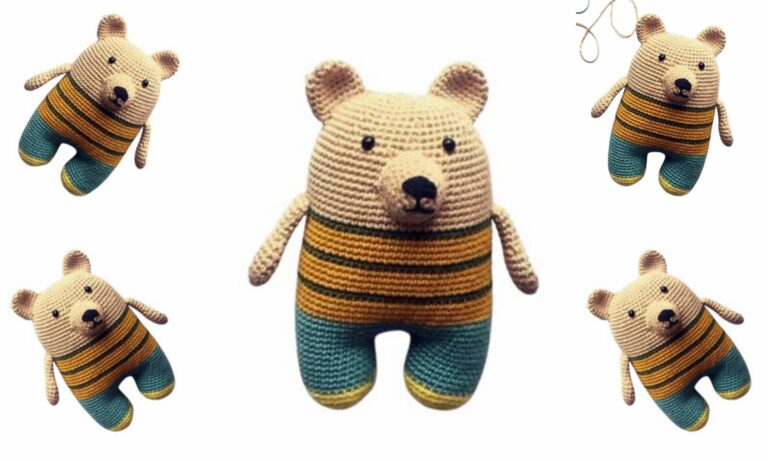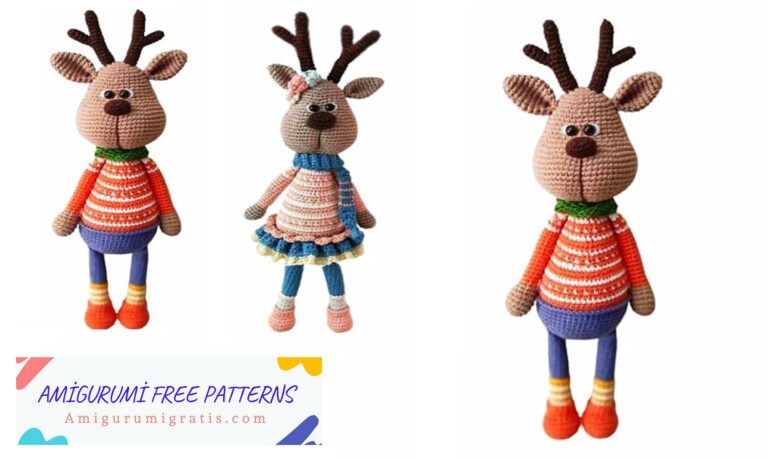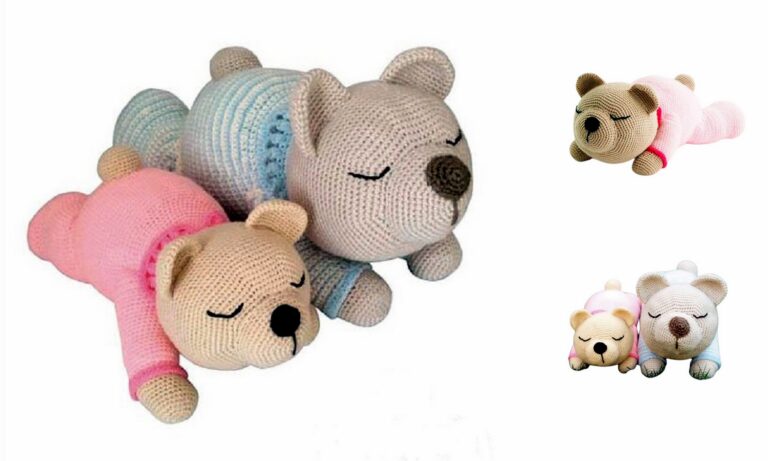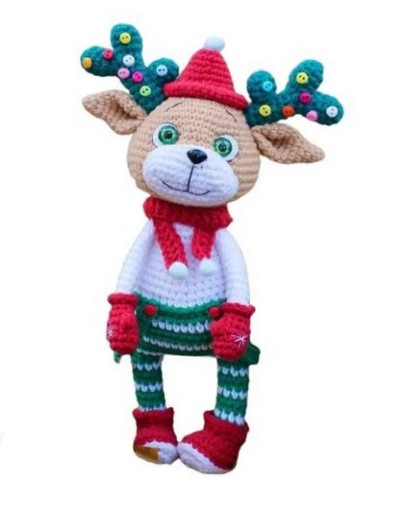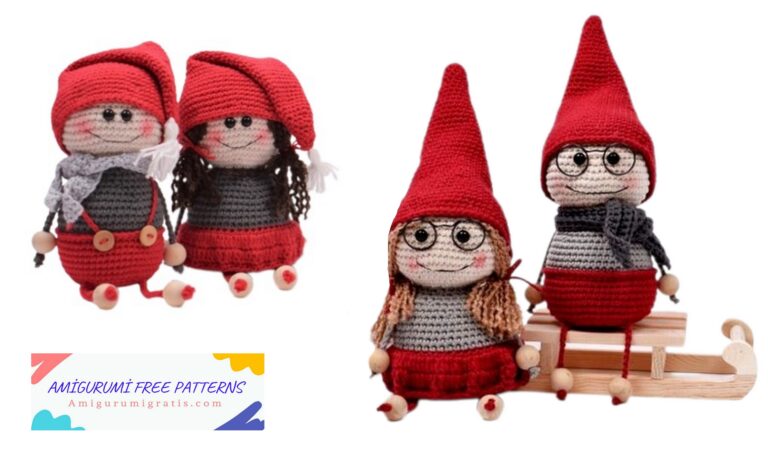Christmas Bear Amigurumi Free Pattern
New year is approaching. Have you knitted your amigurumi toys? A great free pattern christmas bear is here.
(hook + knitting needles)
Material used:
1. Yarn:
Nako Lily (100g – 180m, 100% polyester), color 6651 cream – 1 skein, for the bear’s body.
Alize Lanagold Classik (100g – 240m, 49% wool, 51% acrylic), color 55 white – 1 skein, for the foot
Alize Softy (50g – 115m, 100% micropolyester), color 55 white – 1 skein, for nose
Alize Superlana klasik (100g – 280m, 25% wool, 75% acrylic), color 56 red – 1 skein, for a coat and a hat.
YarnArt Jeans (50g – 160m, 55% cotton, 45% acrylic), color 26 red – 1 skein, for a bag.
YarnArt Mink (50g – 75m, 100% polyamide), color 330 white – 1 skein, for a coat and a hat.
Nako Mohair Delicate (100g – 500m, 40% mohair, 60% acrylic), color 6101 white – 1 skein, for pom poms
2. Filler (holofiber or sindipuch)
3. Hook No. 2.5
4. Needles No. 2.5 (5 pcs) and circular needles on fishing line No. 2.5 – 2 pcs.
5. A needle with a wide eye for stitching details
6. Thick cardboard (plastic) for insoles (I use plastic lids for jars)
7. Cotter pins (2.5 cm) and discs (20 mm) for attaching handles and legs
8. Buttons white and blue (11 mm) for a coat – 3 pieces
9. Half-beads with fastening, for eyes (8 mm) – 2 pieces
10. Spout with fastening, 20 mm wide, 15 mm high
11. Scissors and nippers
12. Yarn in the color of the bear’s body, for tightening the muzzle
13. English clubs to hold parts together
Abbreviations
Ch – air loop
sl-st – connecting post
SC – single crochet
İnc – increase (knit 2 SC in 1 loop)
Dec – decrease (knit 2 SC together)
* – repeat the specified number of times
The number in brackets at the end of each row of the description indicates how many loops there should be in that row.
Purl – front loop
knit – purl loop
k – edge (we remove the first loop, we knit the last one with the purl)
inc – an increase (from one loop we knit two, first for the front wall of the loop, then for the back)
dec – decrease (we knit two loops together)
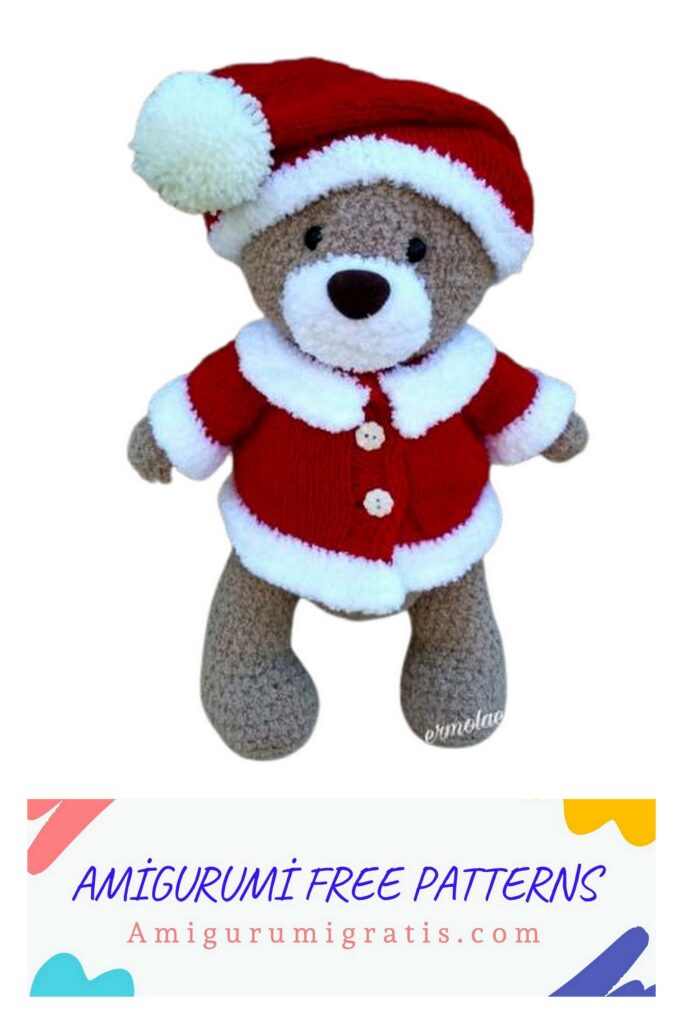
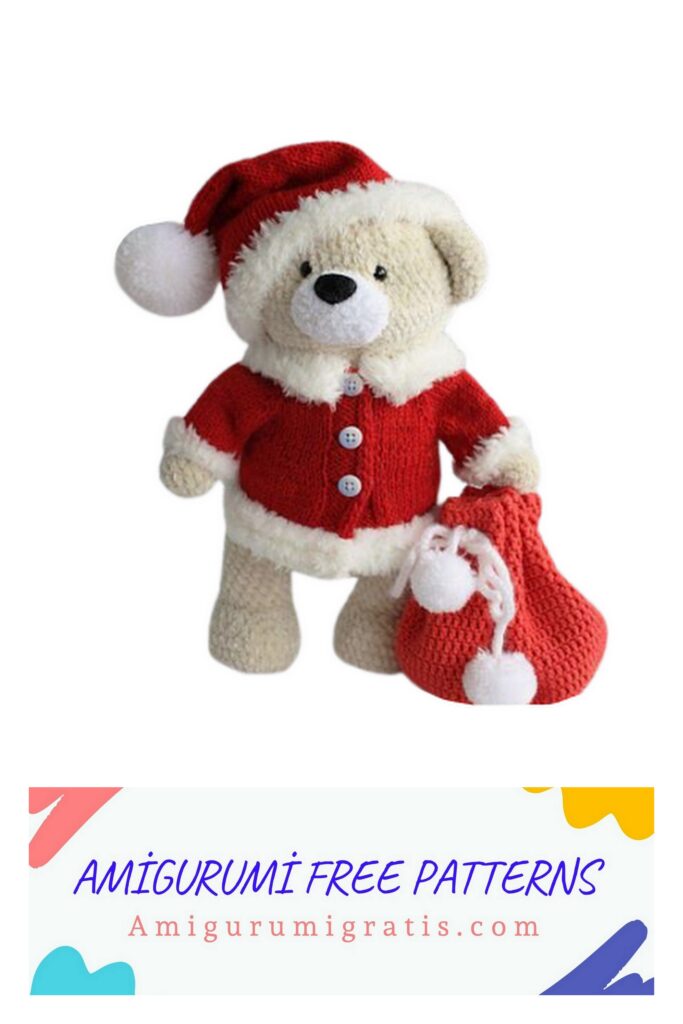
Cotter pin connection:
What is a cotter pin joint, which is traditionally used in a knitted toy, in particular in bears. This is a connection that allows you to give mobility to the arms and legs. They can rotate freely, and the connection is very reliable.
To make in your toy
we need a cotter pin: T-shaped cotter pins, discs, pliers and toy parts.
Take the cotter pin, thread it into the disk and fix it in the first part of the toy.
Then we insert the cotter pin into the second part, put on the disk from above and use the pliers to twist the antennae of the cotter pin clockwise. Everything is very simple!
Legs (2pcs):
Feet (2 pcs):
White thread Alize Lanagold Classik:
1 row: cast on ch 7, starting from the 2nd loop from the hook, knit: 5 SC, 3 SC in the last loop, then knit on the other side of the chain: 4 SC, inc (14)
We continue to knit in a circle.
2nd row: inc, 4 SC, 3 inc, 4 SC, 2 inc (20)
3rd row: 1 SC, inc, 4 SC, (1 SC, inc) * 3, 4 SC, (1 SC, inc) * 2 (26)
4th row: 2 SC, inc, 4 SC, (2 SC, inc) * 3, 4 SC, (2 SC, inc) * 2 (32)
Circle the foot on the plastic and cut out two plastic insoles. For plastic, I used ordinary plastic jar lids.
Change to a cream colored Nako Lily. Cut the white thread, fasten it and hide it.
5 row: for the front half of the loop we knit: 32 SC
6-7 row: 32 SC
8 row: 6 SC, (dec, 1 SC) * 6, dec, 6 SC (25)
9 row: 25 SC
10 row: 6 SC, 7 dec, 5 SC (18)
Insert the plastic insole into the foot:
11-20 row: 18 SC
21 row: (1 SC, dec) * 6 (12)
We stuff the leg tightly enough.
The tighter we fill, the more stable the bear will be.
Between 20 and 21 rows we insert a disc with a cotter pin on the side of the leg. You can read about the cotter pin at the beginning of the MK.
22 Row: dec * 6 (6)
23 row: dec to the end
Similarly, we knit the second leg, only we insert the cotter pin from the opposite side of the leg. These are the legs we got:

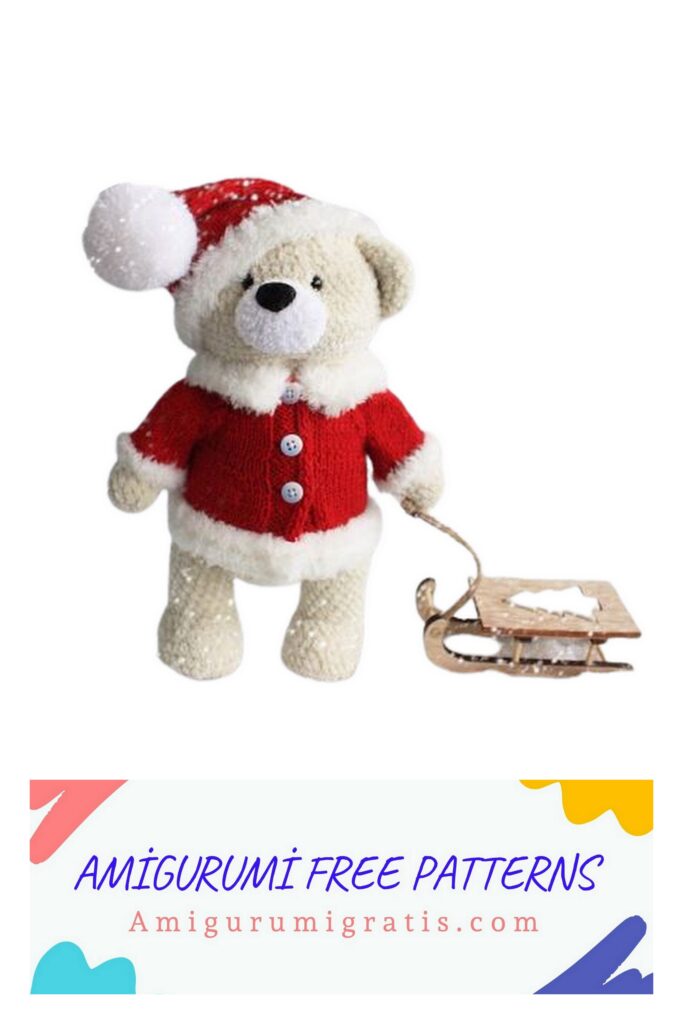
Hands (2 pcs):
1st row: cast on 2 CH and knit 6 SC into the second loop from the hook (6)
Continue knitting in a circle.
2nd row: inc * 6 (12)
3rd row: (inc, 3 SC) * 3 (15)
4-5 row: 15 SC
6 row: 4 sl-st, 11 SC (15)
7 row: 6 SC, 2 dec, 5 SC (13)
8 row: 6 SC, dec, 5 SC (12)
9-17 row: 12 SC
18 row: dec * 6 (6)
We fill our hand tightly. With our hands we shape the fold where we had
connecting posts.
Since our hand is quite narrow, we first insert the disk from above:
And then between rows 17 and 18
cotter pin:
19 row: subtract to the end.
We knit the second hand in the same way:
Torso, head, neck:
1st row: cast on 2 CH and knit 6 SC into the second loop from the hook (6)
Continue knitting in a circle.
2nd row: inc * 6 (12)
3rd row: (SC, inc) * 6 (18)
4th row: (2 SC, inc) * 6 (24)
5 row: (3 SC, inc) * 6 (30)
6 row: (4 SC, inc) * 6 (36)
7 row: (5 SC, inc) * 6 (42)
8 row: (6 SC, inc) * 6 (48)
9th row: (7 SC, inc) * 6 (54)
10 row: (8 SC, inc) * 6 (60)
Insert the cotter pin from the leg between the 8th and 9th rows of the body:
Attention: since the toy is knitted in a spiral, it is possible that on one side the leg (hand or eye) will need to be lowered or raised. So that the legs (arms and eyes) are on the same level.
From the inside, we put a disc on the cotter pin:
And we twist it very, very tight, with pliers “antennae” from the cotter pin. The tighter you twist, the more stable the Bear will stand.
Exactly parallel, on the opposite side of the body, insert the cotter pin of the second leg:
And we fix it in the same way as the first leg.
We got the following legs:
11-20 row: 60 SC
21 row: (18 SC, dec) * 3 (57)
22 row: 57 SC
23 row: (17 SC, dec) * 3 (54)
24 row: 54 SC
25 row: (16 SC, dec) * 3 (51)
26 row: (15 SC, dec) * 3 (48)
27 row: (6 SC, dec) * 6 (42)
We fill the body tightly with filler.
Next, we attach the handles. At the level of 26-27 rows, exactly above the legs, insert
cotter pins from handles:
Like the legs, we twist the “antennae” from the cotter pin with wire cutters:
28 row: (5 SC, dec) * 6 (36)
29 row: (4 SC, dec) * 6 (30)
30 row: (3 SC, dec) * 6 (24)
31 row: (SC, inc) * 12 (36)
32 row: (2 SC, inc) * 12 (48)
33 row: (3 SC, inc) * 12 (60)
34 row: (4 SC, inc) * 12 (72)
35-40 row: 72 SC
41 row: (10 SC, dec) * 6 (66)
42 row: (9 SC, dec) * 6 (60)
43 row: (8 SC, dec) * 6 (54)
44 row: (7 SC, dec) * 6 (48)
We insert eyes between 42 and 43 rows.
There should be a distance of 6 loops or 3 cm between the eyes:
45 row: (6 SC, dec) * 6 (42)
46 row: (5 SC, dec) * 6 (36)
47 row: (4 SC, dec) * 6 (30)
48 row: (3 SC, dec) * 6 (24)
49 row: (2 SC, dec) * 6 (18)
50 row: (SC, dec) * 6 (12)
51 row: dec * 6 (6)
52 row: dec to the end.
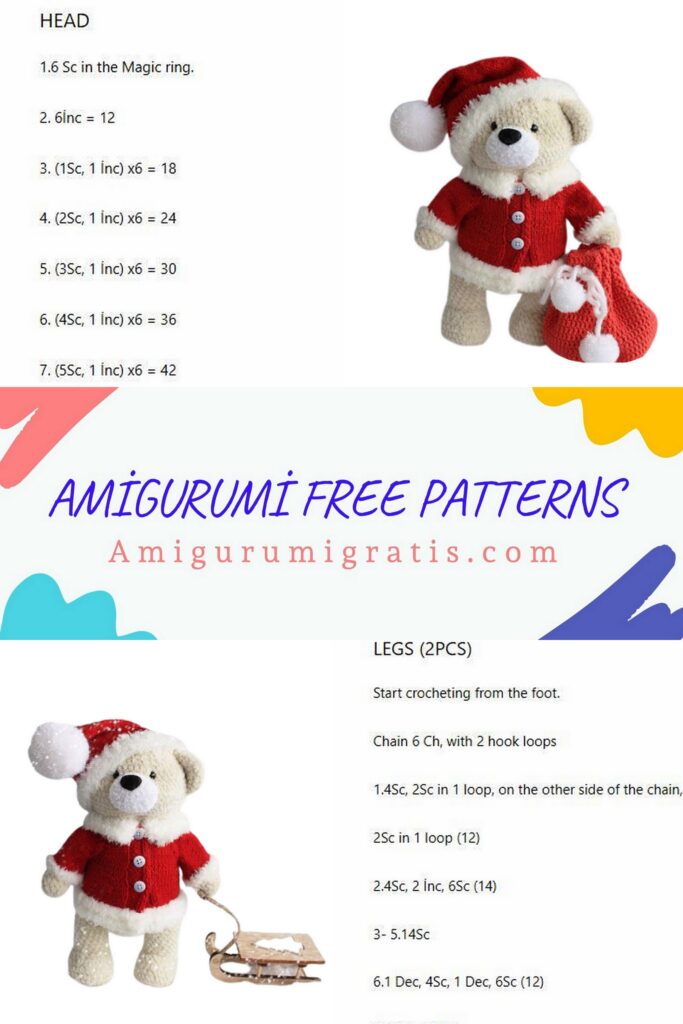
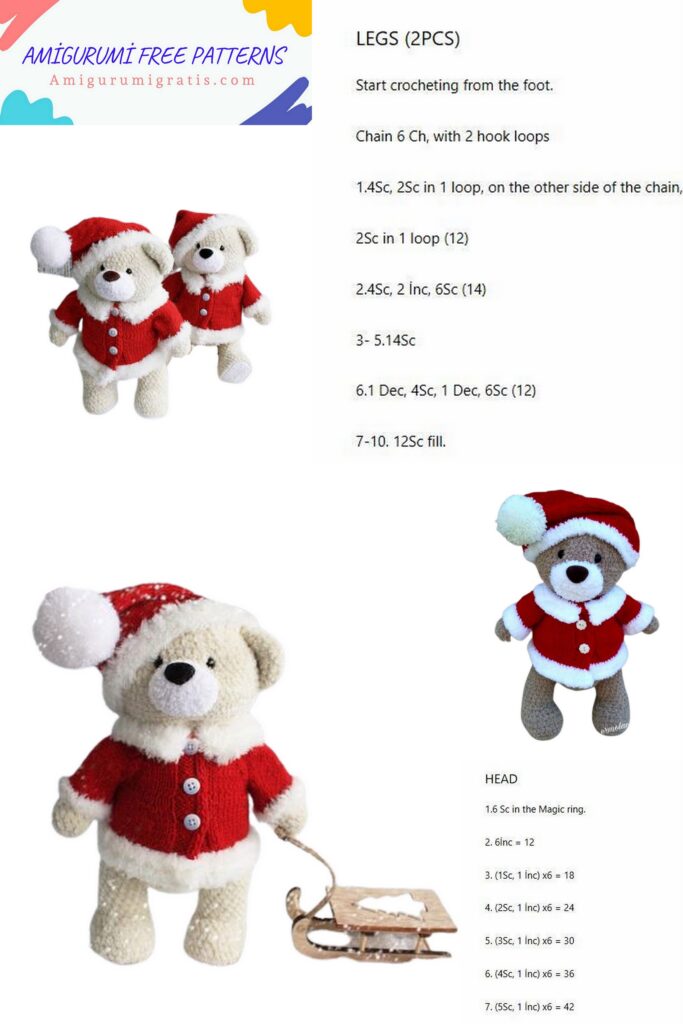
Straighteners:
A needle with a thread for knitting (the color of the bear itself), we enter on the neck, in the middle, as shown in the photo:
We fix the thread and bring it out near the outer corner of the right eye:
Slightly tighten, then grab one loop and re-insert the needle and withdraw it around the neck. Slightly tighten.
On the neck, grab the loop again and bring the needle out near the outer corner of the left eye:
You can also repeat the tightening, but you need to tighten it slightly, slightly. Cut the thread and hide.
We got this form
muzzles:
The eyes seem to be slightly depressed.
Nose:
We knit with Alize Softy white yarn:
1st row: cast on 2 CH and knit 6 SC into the second loop from the hook (6)
Continue knitting in a circle.
2nd row: inc * 6 (12)
3rd row: (SC, inc) * 6 (18)
4th row: inc HDC * 3, 6 SC, inc HDC * 3, 6 SC (24)
5-6 row: 24 SC
Cut the thread, leaving 30 cm for sewing.
Having counted two rows from the top on the nose, insert the nose:
From the inside, we fix the spout:
We attach the nose to the muzzle with clubs:
We carefully sew on our nose:
At the end, the spout needs to be slightly filled:
Below, in the middle of the spout, we make a slight tightening, as shown in the photo:
Our muzzle is ready:
Ears (2 pcs):
1st row: cast on 2 CH and knit 6 SC into the second loop from the hook (6)
Continue knitting in a circle.
2nd row: inc * 6 (12)
3rd row: (SC, inc) * 6 (18)
4th row: (2 SC, inc) * 6 (24)
5-6 row: 24 SC
Cut the thread, leaving 30 cm for sewing.
Fold the ear in half and sew it to the head, counting 4 rows from about the center:
From the inside of the ear, we also sew:
Sew the second ear in the same way:
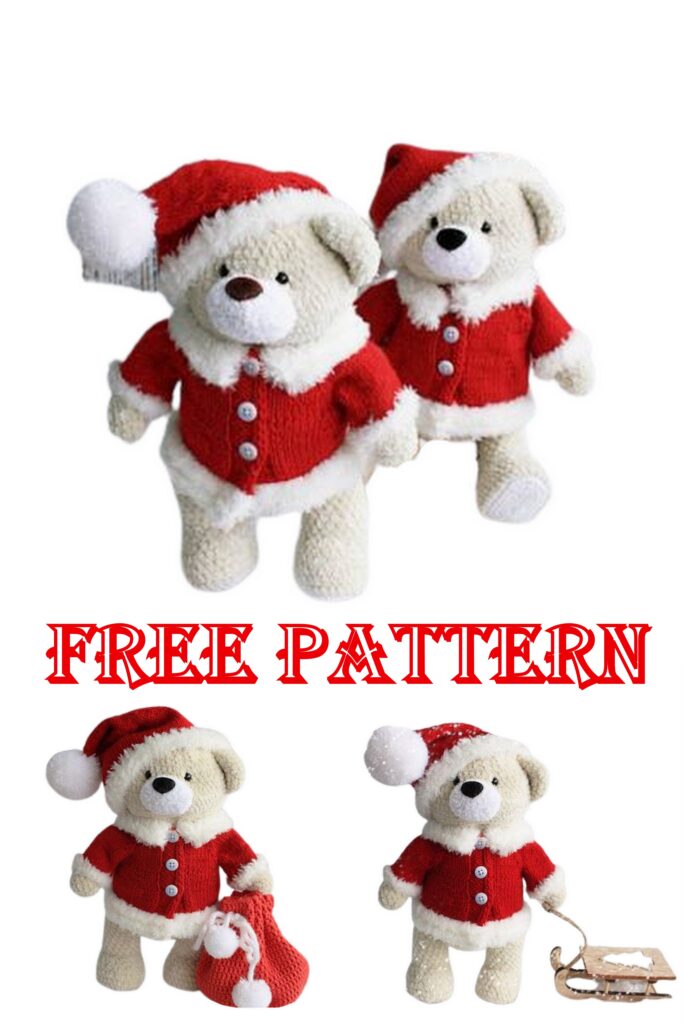
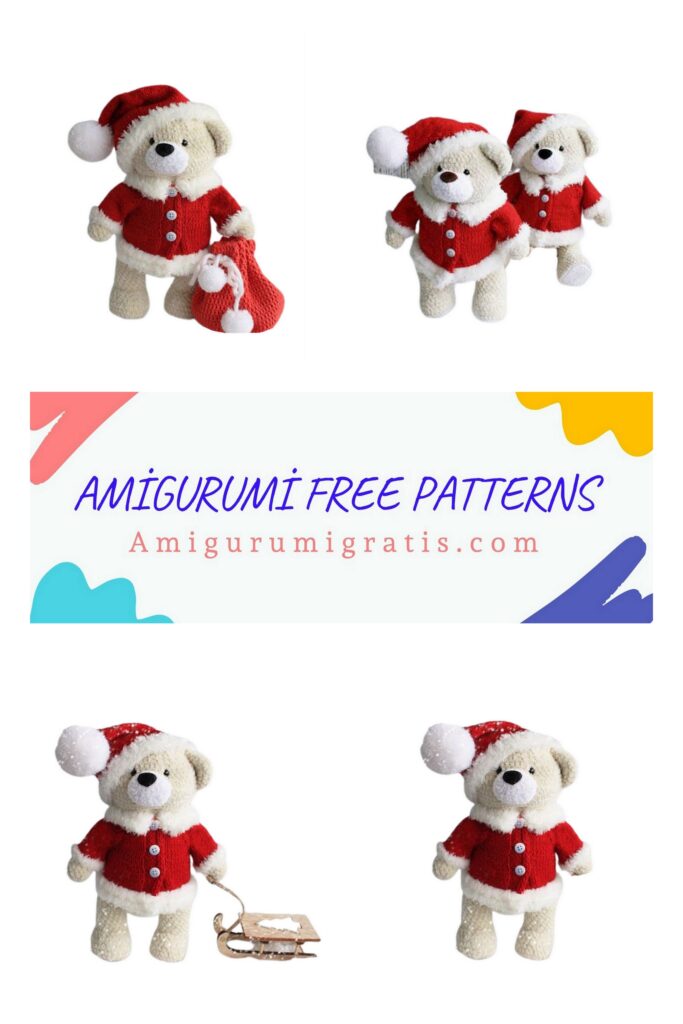
Tail:
1st row: cast on 2 CH and knit 6 SC into the second loop from the hook (6)
Continue knitting in a circle.
2nd row: inc * 6 (12)
3rd row: (SC, inc) * 6 (18)
4-5 row: 18 SC
Cut the thread, leaving 30 cm for sewing.
We attach our tail at the back with English clubs and sew:
At the end, fill the tail lightly, and sew it to the end:
Well, our bear is ready!
It remains to knit a set of clothes for him …
Set of clothes:
First of all, I want to say that when we knit clothes, we should always try them on. Otherwise, it may turn out that the kit will turn out to be large or small. Everyone knits in different ways: someone is free, someone is denser. If you feel that, for example, the coat is not enough, “step back” a little from the scheme suggested in this master class and add an extra loop. In general, a flight of fantasies and forward …
Let’s start this kit with a hat.
Beanie:
(YarnArt Mink yarn in white, Alize Superlana klasik yarn in red, stocking needles No. 2.5 – t, scissors)
With a white thread, we collect 70 loops and distribute them to 4 knitting needles
(17 + 18 + 17 + 18).
Then we knit in a circle.
1st row: 70 purl
2-5 row: (1 purl, 1 knit) * 35 (70)
Change the thread to red. We cut off the white one, fix it and hide it.
6-38 row: 70 purl
39 row: (5 purl, dec) * 10 (60)
40-43 row: 60 purl
44 row: (4 purl, dec) * 10 (50)
45-48 row: 50 purl
49 row: (3 purl, dec) * 10 (40)
50-53 row: 40 purl
54 row: (2 purl, dec) * 10 (30)
55-58 row: 30 purl
59 row: (1 purl, dec) * 10 (20)
60-63 row: 20 purl
In the next row, using a crochet hook, remove all the loops from the needles by one thread.
Pull off the top of the cap.
Turn the cap to the wrong side and tie this thread with a strong knot.
Attention: do not pull the thread too much, otherwise it may break.
Pompon:
(white Nako Mohair Delicate yarn, crochet hook, scissors).
We take a white thread and wind it around our fingers with a thick layer.
Then we thread the hook between the middle and ring fingers:
We grab the cut off thread, 30 cm long. And pull it out to the other side. With this thread we tie our bundle.
Next, remove the bundle from the hand. And with scissors we cut the threads on the sides.
It turned out like this pompom:
We start trimming it. Cut the threads about 1.5 cm so that our pompom is tight. We do not touch the threads that were used to tie our pompom.
For the remaining white threads, we tie a pompom to our hat. We pass the hook through the loops at the tip of the cap and grab the white thread:
We do the same with the second end of the white thread. We pass it from the opposite side.
We tie our threads on a strong knot and cut them in length for a pompom:
Our hat is ready:
Coat:
(YarnArt Mink white yarn, red Alize Superlana klasik yarn, circular needles No. 2.5 – 2 pcs, scissors, buttons – 3 pcs)
We begin to knit the coat with “raglan”, in reverse rows. According to the rules of knitting: we simply remove the first extreme loop, we knit the last one with the purl. When knitting, we will also observe this rule.
Cast on 58 stitches.
1 row: k, 1 purl, 4 knit, 7 purl, yarn, 1 purl, yarn, 7 purl, yarn, 1 purl, yarn, 14 purl, yarn, 1 purl, yarn, 7 purl, yarn, 1 purl, yarn , 7 purl, 4 knit, 1 purl, k (66)
In the next row, we will knit a button hole.
2 row: k, 1 knit, 1 purl, 2 loops close, 55 knit, 4 purl, 1 knit, k (64)
3 row: k, 1 purl, 4 knit, 8 purl, yarn, 1 purl, yarn, 9 purl, yarn, 1 purl, yarn, 16 purl, yarn, 1 purl, yarn, 9 purl, yarn, 1 purl, yarn , 8 purl, 1 knit, 2 yarns, 1 knit, 1 purl, k (74)
4th row: k, 1 knit, 4 purl, 62 knit, 4 purl, 1 knit, k (74)
5 row: k, 1 purl, 4 knit, 9 purl, yarn, 1 purl, yarn, 11 purl, yarn, 1 purl, yarn, 18 purl, yarn, 1 purl, yarn, 11 purl, yarn, 1 purl, yarn , 9 purl, 4 knit, 1 knit, k (82)
6 row: k, 1 knit, 4 purl, 70 knit, 4 purl, 1 knit, k (82)
7 row: k, 1 purl, 4 knit, 10 purl, yarn, 1 purl, yarn, 13 purl, yarn, 1 purl, yarn, 20 purl, yarn, 1 purl, yarn, 13 purl, yarn, 1 purl, yarn , 10 purl, 4 knit, 1 knit, k (90)
8 row: k, 1 knit, 4 purl, 78 knit, 4 purl, 1 knit, k (90)
9 Row : K, 1 purl, 4 knit, 11 purl, yarn, 1 purl, yarn, 15 purl, yarn, 1 purl, yarn, 22 purl, yarn, 1 purl, yarn, 15 purl, yarn, 1 purl, yarn , 11 purl, 4 knit, 1 knit, k (98)
10 row: k, 1 knit, 4 purl, 86 knit, 4 purl, 1 knit, k (98)
Row 11: k, 1 purl, 4 knit, 12 purl, yarn, 1 purl, yarn, 17 purl, yarn, 1 purl, yarn, 24 purl, yarn, 1 purl, yarn, 17 purl, yarn, 1 purl, yarn , 12 purl, 4 knit, 1 knit, k (106)
12th row: to, 1 knit, 1 purl, 2 loops close, 94 knit, 4 purl, 1 knit, to (104) (In this row there is a hole for a button)
Row 13: k, 1 purl, 4 knit, 13 purl, yarn, 1 purl, yarn, 19 purl, yarn, 1 purl, yarn, 26 purl, yarn, 1 purl, yarn, 19 purl, yarn, 1 purl, yarn , 13 purl, 1 knit, 2 yarns, 1 knit, 1 purl, k (114)
Row 14: k, 1 knit, 4 purl, 102 knit, 4 purl, 1 knit, k (114)
15 row: K, 1 purl, 4 knit, 14 purl, transfer 23 loops to an additional knitting needle, 28 purl, 23 loops to transfer to an additional knitting needle, 14 purl, 4 knit, 1 purl, k (68)
16 row: k, 1 knit, 4 purl, 14 knit, 5 yarns, 28 knit, 5 yarns, 14 knit, 4 purl, 1 knit, k (78)
We make yarn overs with such loops from the thread:
17 row: k, 1 purl, 4 knit, 7 purl, inc, (12 purl, inc) * 4, 6 purl, 4 knit, 1 purl, k (83)
18 row: k, 1 knit, 4 purl, 71 knit, 4 purl, 1 knit, k (83)
Here are the holes for the sleeves we got:
19 row: k, 1 purl, 4 knit, 8 purl, inc, (13 purl, inc) * 4, 6 purl, 4 knit, 1 purl, k (88)
20 row: k, 1 knit, 4 purl, 76 knit, 4 purl, 1 knit, k (88)
21 row: k, 1 purl, 4 knit, 9 purl, inc, (14 purl, inc) * 4, 6 purl, 4 knit, 1 purl, k (93)
22 row: k, 1 knit, 1 purl, 2 loops close, 81 knit, 4 purl, 1 knit, k (91) (In this row there is a hole for a button)
23 row: k, 1 purl, 4 knit, 81 purl, 1 knit, 2 yarns, 1, knit, 1 purl, k (93)
24,26,28,30 row: k, 1 knit, 4 purl, 81 knit, 4 purl, 1 knit, k (93)
25,27,29 row: k, 1 purl, 4 knit, 81 purl, 4 knit, 1 purl, k (93)
31 row: close all loops.
Cut the red thread, fix and hide.
32 row: attach the white thread and knit by the front half of the loop:
93 SC, CH, turn (93)
33-35 Row: 93 SC, CH, turn (93)
36 row: 93 SC
Sleeve:
We attach a red thread and knit:
1 row: we have 23 loops on the additional knitting needle and we also get 9 loops from the bottom of the sleeves, knitting them with the front ones.
Thus, we have all the loops divided into 4 knitting needles, 8 loops each.
Row 2-11: 32 purl
Change the thread to white. Cut off the red one, fasten it and hide it.
12-14 row: 32 purl
15 row: close all loops.
Similarly, we knit the second sleeve:
Collar:
We attach a white thread on top of the coat, from the wrong side, as shown in the photo:
and we knit:
1st row: 52 SC
2nd row: (9 SC, inc, 10 SC, inc) * 2, 9 SC, inc (57)
3rd row: inc, 10 SC, (inc, 11 SC, inc, 10 SC) * 2 (62)
4th row: (11 SC, inc, 12 SC, inc) * 2, 11 SC, inc (67)
5 row: inc, 12 SC, (inc, 13 SC, inc, 12 SC) * 2 (72)
Sew on 3 buttons on the front side, opposite the button slots.
Our coat is ready:
Bag:
(yarn YarnArt Jeans red, yarn yarn Nako Mohair Delicate
white, hook number 2.5, needle, scissors)
1st row: cast on 2 ch and knit 6 SC into the second loop from the hook
2nd row: 2 SC in 1 loop – 6 times (12)
3rd row: 2 DC in 1 loop – 12 times (24)
4th row: (1 DC, 2 DC in 1 loop) * 12 (36)
5 row: (2 DC, 2 DC in 1 loop) * 12 (48)
6 row: (3 DC, 2 DC in 1 loop) * 12 (60)
7 row: (4 DC, 2 DC in 1 loop) * 12 (72)
8 row: for the back half of the loop: (5 DC, 2 DC in 1 loop) * 12 (84)
9th row: (6 DC, 2 DC in 1 loop) * 12 (96)
10-27 row: 96 DC
You can knit the pouch higher by adding rows.
Lace:
We knit the lace with white thread – Nako Mohair Delicate. Leaving about 30 cm, do CH:
Then we throw the thread that we left on the hook:
And we pull the main thread through the formed 2 loops:
Then we throw in the remaining thread again, and again we stretch the main thread. And so we knit the lace to the length you need. I got 150 stitches, or about 45 cm long.
We thread the lace into the top of the bag. I retreated from the top edge of the 2nd row, but in order for the top of the bag to look more beautiful, retreat better than 3-4 rows. Lace
we pass through every 5 loops:
Next, we make 2 small pom-poms, as for a hat:
And using a needle, we sew them to the ends of the lace:
Our bag is ready:
We dress our bear and admire the result!
